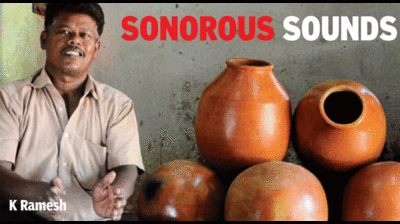- News
- City News
- chennai News
- Electric kiln to fire ghatams
Trending
This story is from September 12, 2016
Electric kiln to fire ghatams
Ghatam-making is a proud tradition in Ramesh's family that has been carried forward for more than five generations. In 2013, his mother Meenakshi was honoured with the prestigious Sangeet Natak Akademi award in 2013, for her proficiency in ghatam making but the family's plea for monetary support for pursuing the craft has yielded no response.

Ghatam, pot in Sanskrit, is an ancient percussion instrument in Carnatic music. Made of clay with brass or copper fillings, it needs a special design to produce the distinctive sound.
Ghatam-maker from Manamadurai raises Rs 5 lakh for technology that will prevent wastage
When a craft honed for centuries turns to new-age technology for its survival it meets with interesting results from unexpected corners. When Mannamadurai-based ghatam maker K Ramesh posted on social media about his efforts to raise funds to build an electric kiln to make ghatams, little did he expect that his plea would attract the attention of hundreds of music enthusiasts, and maestros including renowned ghatam player Vikku Vinayakram and vocalist T M Krishna.
On Thursday, Ramesh successfully raised Rs 5 lakh (from 146 people), on crowdfunding platform Ketto.org, four days before the deadline.
Ghatam-making is a proud tradition in Ramesh's family that has been carried forward for more than five generations. In 2013, his mother Meenakshi was honoured with the prestigious Sangeet Natak Akademi award in 2013, for her proficiency in ghatam making but the family's plea for monetary support for pursuing the craft has yielded no response. "We've been petitioning the state and the Centre for the past 40 years for an acre of land to practise our craft, but there has been no response. It was by accident that I stumbled upon this crowdfunding platform," says Ramesh. Mounds of half-baked clay from broken clay pots made Ramesh look for an alternative to the delicate firing process in ghatam making. Ramesh found an eco-friendly substitute in the electric kiln, which can control temperature and ensure less wastage during making of the instrument.
The family from the famed town of ghatam makers has a wide fan-base for its unique ghatams. "We've supplied to maestros like Salem Vaiyapuri and EM Subramaniam, who used to play for Kunnakudi Vaidyanathan. I remember getting Rs 15 from him when I delivered the instrument," says Ramesh, who supplies ghatams to Andhra Pradesh, Karnataka, New Delhi, Maharashtra and even couriers them overseas to Singapore and Sri Lanka.
Ramesh was initiated to the traditional craft by his grandfather. "My first ghatam made at the age of 11 surprisingly was sold. Now it's been more than 30 years since that day and I still haven't lost my love or fascination for it. We keep improvising and innovating," says the 46-year-old.
When a craft honed for centuries turns to new-age technology for its survival it meets with interesting results from unexpected corners. When Mannamadurai-based ghatam maker K Ramesh posted on social media about his efforts to raise funds to build an electric kiln to make ghatams, little did he expect that his plea would attract the attention of hundreds of music enthusiasts, and maestros including renowned ghatam player Vikku Vinayakram and vocalist T M Krishna.
On Thursday, Ramesh successfully raised Rs 5 lakh (from 146 people), on crowdfunding platform Ketto.org, four days before the deadline.
Ghatam-making is a proud tradition in Ramesh's family that has been carried forward for more than five generations. In 2013, his mother Meenakshi was honoured with the prestigious Sangeet Natak Akademi award in 2013, for her proficiency in ghatam making but the family's plea for monetary support for pursuing the craft has yielded no response. "We've been petitioning the state and the Centre for the past 40 years for an acre of land to practise our craft, but there has been no response. It was by accident that I stumbled upon this crowdfunding platform," says Ramesh. Mounds of half-baked clay from broken clay pots made Ramesh look for an alternative to the delicate firing process in ghatam making. Ramesh found an eco-friendly substitute in the electric kiln, which can control temperature and ensure less wastage during making of the instrument.
"Only after a ghatam is fired does one know if it is musical. Ghatams can get damaged in the firing process if there is a difference in temperature levels, which is often when we bake in an open kiln," says Meenakshi. "A gust of wind, can ruin the work of days. And since baked clay cannot be reused it's a huge drain on our slim resources." Controlled temperature in an electric kiln makes the risk of a ghatam breaking negligible.
The family from the famed town of ghatam makers has a wide fan-base for its unique ghatams. "We've supplied to maestros like Salem Vaiyapuri and EM Subramaniam, who used to play for Kunnakudi Vaidyanathan. I remember getting Rs 15 from him when I delivered the instrument," says Ramesh, who supplies ghatams to Andhra Pradesh, Karnataka, New Delhi, Maharashtra and even couriers them overseas to Singapore and Sri Lanka.
Ramesh was initiated to the traditional craft by his grandfather. "My first ghatam made at the age of 11 surprisingly was sold. Now it's been more than 30 years since that day and I still haven't lost my love or fascination for it. We keep improvising and innovating," says the 46-year-old.
End of Article
FOLLOW US ON SOCIAL MEDIA











